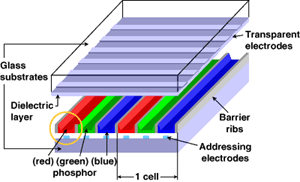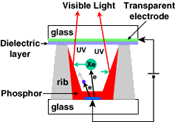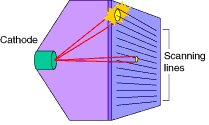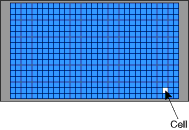
HOME
NEWS
MY PICTURES
MY COMPONENTS
HUGE DVD LINKS
THE MOVIE LIST
EMAIL ME
What is Plasma Technology?
Soon, the terms "PDP"
and "Plasma Display" will probably be as familiar as
"TV" and "CRT" are today. But plasma display technology
is so new that not many people know even the basic concepts that underlie
the technology yet. Here is a basic primer.
| |
|
|
|
|
Definition:
Plasma is the state of a matter where
atoms are ionized by adding energy. In the context of plasma
display technology, electricity is used to illuminate a gas stored
in cells of the display panel, very similar to the way a
fluorescent or neon light works. |
|
| |

|
|
A plasma display unit is a panel
that consists of many tiny cells filled with a neon xenon gas. When
voltage is applied between two electrodes inside a cell, ultraviolet
radiation excites the phosphors lining the cell and light is produced. Do
this for every cell in the display, and voilą
-- a bright, crystal clear image is the result.
Basic Cell Structure
Inside the PDP-505HD's plasma
panel, a series of red, green, and blue cells are grouped in a precise
matrix. These cells are activated individually, unlike standard CRTs or
LCDs. This means that they emit light individually, creating a precise
pixel on the viewing area.

The Principle of Light
Emission
The diagram below illustrates
light emission for a single color. This occurs 3 times in each PDP panel
cell -- once each for red, green and blue emissions.
|

|
SEQUENCE
OF EVENTS:
Movement of
electrons
Multiplication of electrons by gas ionization: Plasma
Xe excitation
UV radiation
Phosphor excitation
Visible light emission
|
CRT Vs. Plasma
PLASMA DISPLAY: A
Distortion-Free Image
The advent of HDTV,
SDTV, DVD, and other new media have created a demand for larger,
higher-resolution displays. Pioneer's new plasma display technologies
demonstrate inherent engineering advantages over conventional CRTs
(Cathode Ray Tubes) and LCD (Liquid Crystal Display) panels.
Comparison:
CRT vs Plasma Display Panel
|
Cathode Ray Tube (CRT)
|
Plasma
Display Panel (PDP)
|
|

|

|
CRT
TECHNOLOGY:
CRTs use a beam of electrons to stimulate phospors and
thus make the image. The beam strikes the phospor cells at an
angle, however, and this creates a larger spot size. Also,
because it is difficult to focus the beam at all points, the
image will be less precise in some areas. |
PLASMA
TECHNOLOGY:
Plasma Display Panels stimulate phosphor cells
individually with electrodes. There is no loss of focus. |
CRT
RESULTS:
- Geometric
distortion.
The picture on a CRT will always have a certain
amount of distortion.
- Uneven light
output.
The picture on a CRT will have areas that are
brighter and areas that are darker than others.
- Difficulty
focusing across the entire screen.
The picture on a CRT will have some regions that are
not as focused as others.
- Picture
distorted by magnetic fields.
The CRT's electron beam can be influenced by magnetic
fields, which results is a distorted image.
|
PLASMA
RESULTS:
- No geometric
distortion.
The plasma panel's accurate cell structure produces a
picture that is geometrically perfect.
- Even light
output.
The plasma panel is perfectly evenly illuminated - no
dark or hot spots.
- Perfect
focus.
The plasma panel has perfect focus across the entire
screen.
- No
susceptibility to magnetic fields.
The plasma panel is not affected by magnetic fields.
|
Also See:
HDTV
Explained!
How Does DVD Work?
World
Regional Coding
What is Surround Sound?
What is an Anamorphic DVD?
What Can I Watch on My Home
Theater?
DVD-ROM vs. DVD
Dolby
Digital 5.1 Channel Surround
HOME
NEWS
MY PICTURES
MY COMPONENTS
HUGE DVD LINKS
THE MOVIE LIST
EMAIL ME |